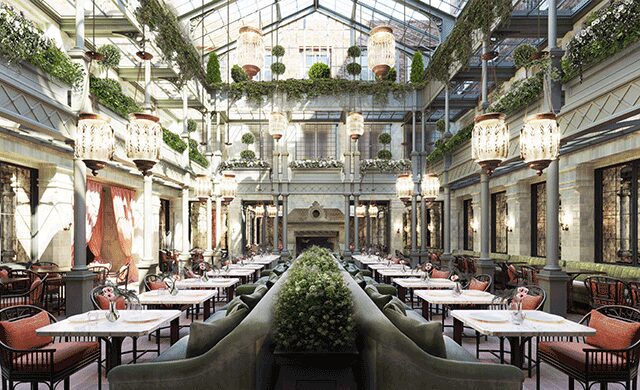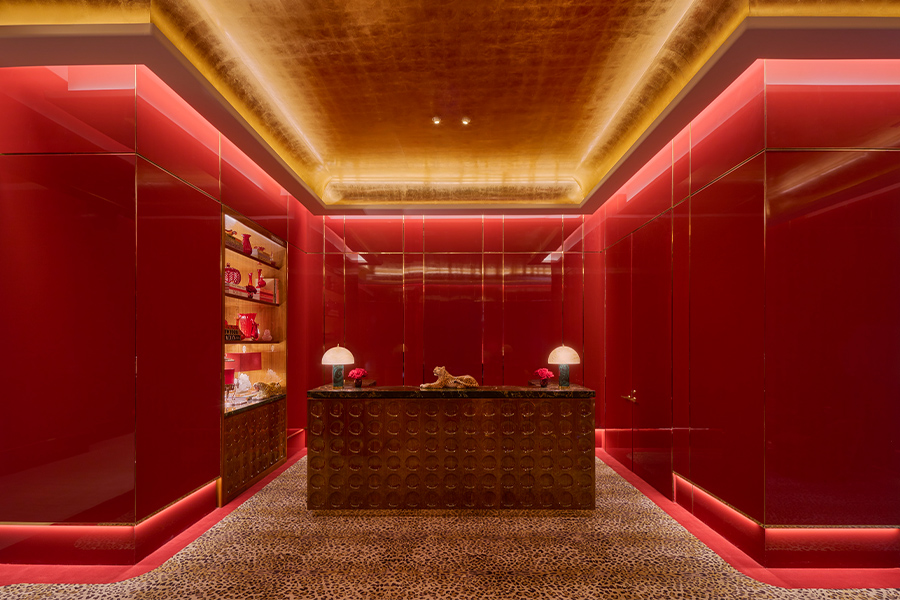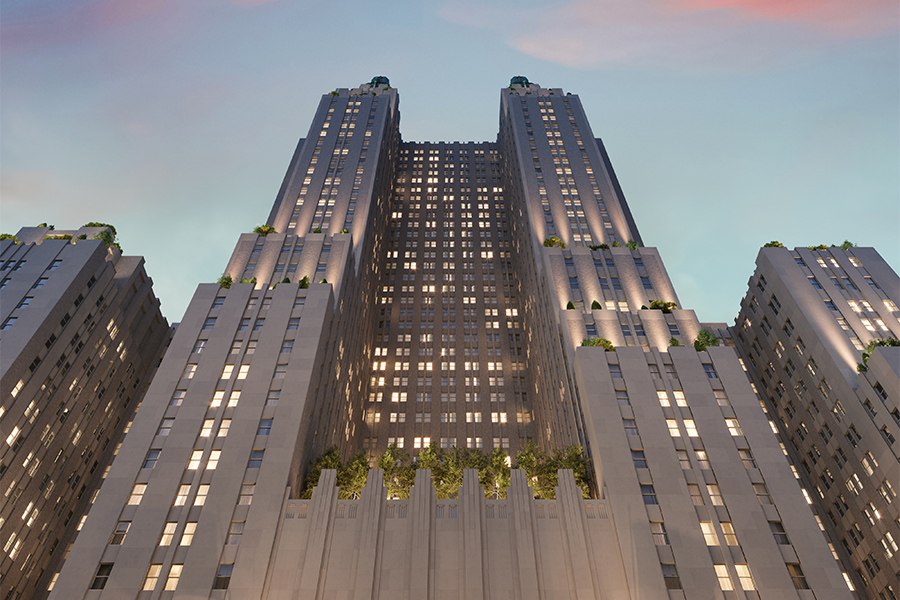
A rendering of the forthcoming NoMad London, designed by Roman and Williams
With an influx of new hotels, London continues to be an essential must-visit global city and cultural hub. Around 11,000 new rooms are expected to come online by 2020, with the majority of properties opening this year, including Great Scotland Yard, part of the Unbound Collection by Hyatt (from HBA’s Dubai office), One Aldwych in Covent Garden by London’s Robert Angell Design International, and the Millennium will be converted into the Biltmore, Mayfair—the first European property in Hilton’s LXR Hotels and Resorts portfolio—courtesy of London-based Goddard Littlefair.
Likewise, homegrown brand the Hoxton will open its third UK outpost in Southwark, with in-house Ennismore Design Studio taking cues from the neighborhood’s bygone leather tanneries and factories. Meanwhile, NH Hotel Group will plant a nhow flag in the city this summer at Foster + Partners’ 250 City Road development led by local firm Project Orange. Two U.S.-based brands will hop across the pond, as well. The Standard will enter London this year in the old Camden Town Hall Annexe in King’s Cross from locally and Los Angeles-based Shawn Hausman Design, while Sydell Group, in partnership with BTC UK, are set to welcome the NoMad London to Covent Garden next summer. New York firm Roman and Williams will transform the former 19th-century courthouse and police station into the 91-room hotel, where chef Daniel Humm and restaurateur Will Guidara will introduce their sought-after F&B offerings to the city.
Ranging from noteworthy renovations to new builds, here’s a look at the impressive lineup of hotels redefining the city’s skyline.
Mandarin Oriental Hyde Park, London
A fire forced it to temporarily shutter, but now Knightsbridge icon the Mandarin Oriental Hyde Park has completed its extensive refurbishment. By the end of last year, the public spaces were ready for primetime, including the Mandarin Bar, for which New York-based Tihany Design opted for a new color scheme. Now, blue and violet furniture complement handblown copper glass light fixtures and an enigmatic gold-frosted gradient glass wall partition. The spa, also courtesy of Tihany, is rife with Chinese-inspired choices, bringing together materials like bronze, gold metal mesh, and silver leaf.
Art Deco-era sophistication is a hallmark of the 181 guestrooms—the 40 suites include a three-bedroom penthouse—which incorporate graceful accents like bedside sconces with clasped jewel detailing. But it’s Hyde Park, directly outside the hotel, that made a powerful impression on London- and Hong Kong-based Joyce Wang Studio. “I love looking out to the park and feeling its extension behind me with the material combination propagating its color and textures. There’s no greater satisfaction than feeling light permeate every corner of a room that was once dim and dowdy,” says principal Joyce Wang.
Bankside Hotel
Last fall, the eco-friendly Bankside Hotel, part of Marriott’s Autograph Collection, opened in a glass building in architect Ian Simpson’s One Blackfriars Development. The 161-room hotel, influenced by its neighbor the Tate Modern, is graced with works by the likes of London ceramicist and illustrator Laura Carlin and Glasgow-based fabric house Timorous Beasties. Custom East London architectural images hanging above the beds infuse guestrooms with an energetic, urban flair. “I wanted spaces that support creative work in progress and let the South Bank spirit live on with a sense of intimacy and style,” says Dayna Lee, principal of LA-based Powerstrip Studio, which, propelled by a passion for black line drawings and midcentury looks, dreamed up the hotel’s design. Butcher-block timber flooring and a white metal and brass-striped rail staircase greet guests in the lobby, where a fireplace is set into a sculptural chimney. Gesso walls and concrete blocks are reminiscent of the 1950s, yet engage in dialogue with contemporary, handmade furniture. Bankside, says Lee, is a “haven for curious, buzzing worker bees and global nomads who could do with some pied-à-terre comfort.”
Belmond Cadogan Hotel
First built in 1887, the Cadogan Hotel comprised five buildings and attracted personalities like Oscar Wilde and Lillie Langtry. Now, with its Queen Anne-Revival style intact, it’s the 54-room Belmond Cadogan, featuring a bar in what was once the Union Bank of England.
A collaboration between local firms Blair Associates Architecture and GA Group, as well as Russell Sage Studio for the F&B spaces, the revamped hotel is awash in a palette of deep red and brown. It stars made-in-England furniture, a staircase that looks as if it were plucked from a grand English country manor, and a collection of some 400 artworks, largely by female British artists, while botanical motifs nod to the adjacent Cadogan Place Gardens and annual Chelsea Flower Show. “Using a variety of wood, marble, and metal that have their own understated aesthetic helped create an ambiance of luxury, and one that will age gracefully,” says Joe Ferry, Belmond’s London-based art and design director.
The Dixon
Situated in what was the Tower Bridge Magistrates’ Court and police station, the 193-room Dixon pays homage to the circa-1905 building’s former life and its original architect, John Dixon Butler. Rani Ahluwalia, creative director at M Studio London, worked in tandem with local firm Twenty2Degrees and Belfast-based architects Consarc Design Group to restore many of the building’s original features, including Edwardian oak panels that conjure a feeling of elegance.
The union of finely crafted metalwork and glassware spawned three centerpiece chandeliers in the reception, Courtroom Bar, and lobby, where the fixture encompasses 60 glass handcuffs embedded with gold leaf and woven with 9,000 glass gold spheres and 18,000 crystal beads. Metalwork is illuminated elsewhere in the Dixon, like the prisoner-etched benches salvaged from old cells that have found a second life in the lobby, corridors, elevators, and master suite. “We also kept the keys from each of the cells, weaving them into metal artwork,” says Ahluwalia.
Stratford
Stratford, the retail and leisure hub that was home of the London Summer 2012 Olympics, takes a luxurious turn this month with the opening of a namesake hotel. The 145-room property, helmed by Space Copenhagen, is tucked inside the SOM-crafted Manhattan Loft Gardens, the new 42-story skyscraper from the minds behind Chiltern Firehouse and St. Pancras Renaissance Hotel London that melds residential and hospitality.
To achieve a design that fostered a sense of community for both residents and short-term guests, Space Copenhagen cofounder Signe Bindslev Henriksen says she and partner Peter Bundgaard Rützou “focused on the sense of continuity between areas, hoping to accentuate the feeling of ease and comfort that merged residents and guests into shared, open spaces.” Embracing a hushed, delicate palette of pastels, the duo harmoniously layered in darker jewel and gray tones, Scandinavian influences, and natural materials, including light wood and patinated metals. “Our choice in such materials is a look toward modernity, and perhaps even a nod in the direction the area of Stratford is heading,” says Bundgaard Rützou.


